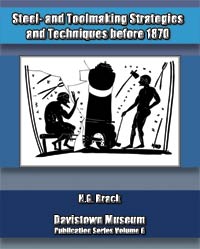
 Steel- and Toolmaking Strategies and Techniques before 1870
Steel- and Toolmaking Strategies and Techniques before 1870
H.G. Brack
1st edition, 2008
An exploration of technologies used by Iron Age, Roman, Medieval, and Renaissance metallurgists and toolmakers. Includes commentary on iron and steel-making techniques, the technological innovations of the early Industrial Revolution, the production of natural, German, blister, and cast steel, and the evolution of alloy and high speed steels.
Softcover, 8" x 10"
$15.00
Available on Amazon.com
Hand Tools in History Publication Series Summary
Volume 6: Steel- and Toolmaking Strategies and Techniques before 1870 explores ancient and early modern steel- and toolmaking strategies and techniques, including those of early Iron Age, Roman, medieval, and Renaissance metallurgists and toolmakers. Also reviewed are the technological innovations of the Industrial Revolution, the contributions of the English industrial revolutionaries to the evolution of the factory system of mass production with interchangeable parts, and the development of bulk steelmaking processes and alloy steel technologies in the latter half of the 19th century. Many of these technologies play a role in the florescence of American ironmongers and toolmakers in the 18th and 19th centuries. Author H. G. Skip Brack cites archaeometallurgists such as Barraclough, Tylecote, Tweedle, Smith, Wertime, Wayman, and many others as useful guides for a journey through the pyrotechnics of ancient and modern metallurgy. Volume 6 includes an extensive bibliography of resources pertaining to steel- and toolmaking techniques from the early Bronze Age to the beginning of bulk-processed steel production after 1870.
Amazon.com description
In the first volume of the Hand Tools in History series, Davistown Museum curator H. G. Skip Brack takes readers on a journey through the pyrotechnics of ancient and modern ferrous metallurgy. Citing major archaeometallurgists, he explores steel- and toolmaking from the early Iron Age through the Renaissance and then covers the technological innovations that led to the Industrial Revolution, the factory system of mass production, and development of 19th century bulk steelmaking processes. Brack discusses the historical diversity of steelmaking strategies and the important role they played in the florescence of American ironmongers and toolmakers in the 18th & 19th centuries. The volume includes an extensive bibliography of resources. History and tool buffs, blacksmiths, and anyone interested in steel- and toolmaking and the evolution of America’s maritime and industrial economy will find Brack’s work invaluable.